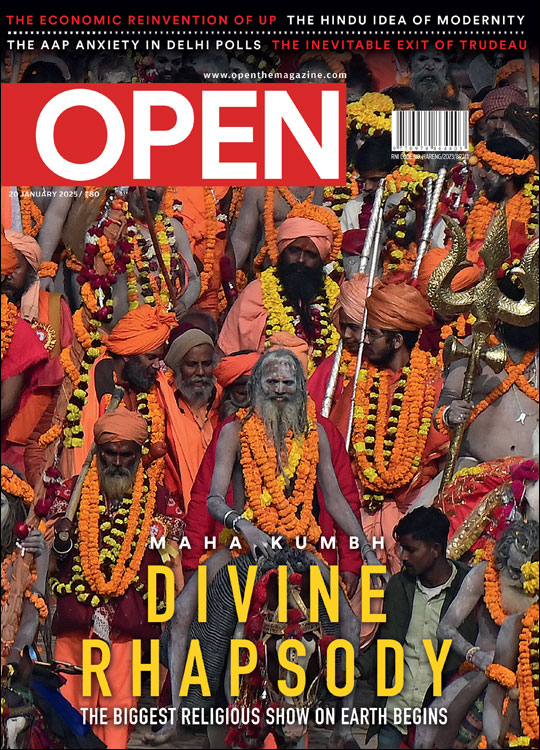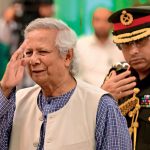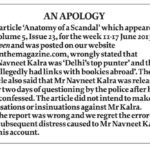Jagendra Singh: The death of a journalist
Who killed Jagendra Singh—and why? Text and photographs by Omkar Khandekar in Shahjahanpur, Uttar Pradesh
 Omkar Khandekar
Omkar Khandekar
 Omkar Khandekar
Omkar Khandekar
 |
25 Jun, 2015
|
25 Jun, 2015
/wp-content/uploads/2016/01/18936.deathofajournalist1.jpg)
Like many others over the past week, these visitors too have reached Khutar village in an SUV with its windows rolled up. The journalists lounging around the tent shake off their hibernation and follow their cameramen towards the parking spot. Three people, well in their fifties, alight from the vehicle and walk towards the heart of the assembly, where members of Jagendra Singh’s family are staging a dharna.
A local journalist, apparently a mediator between the visitors and the family, introduces the new arrivals as members of the Press Council of India (PCI). The family had been told to expect them. Abandoning the makeshift dais, they make their way to the twin-storeyed house across the street. Under the glare of media cameras, the PCI team follows them inside. The doors shut behind them. Most journalists retreat to their spot under a peepal tree.
Twenty minutes later, the team heads back to its egg-on-wheels. Questions are flung at them. Answers, at first, are avoided before an official statement is issued to pacify the clamouring journalists. While the father Sumer Singh, elder son Rajvender and daughter Rachana are back at the dharna, the mother Suman and younger ward Rahul are nowhere to be seen. I walk to their house and spot the two leaning against a courtyard wall, pacifying the sons’ aunt, Lovely Singh.
“…what was the point of shouting at them?” Rahul is saying.
“They come here, ask questions about what happened—to you, me, others. They have all seen him after he was set on fire, saying who was responsible. And yet they all want to conduct investigations,” the aunt rants. “Why can’t they just punish the minister right away?”
Seeing his mother shrivel up in a corner, Rahul reiterates the importance of their ‘fight’, one they are putting up “without food or water, under the hot sun”. Lovely refuses to be consoled but keeps mum. Finally, Rahul tells her that she’d better compose herself. Some mausi has come to meet her. “Hogi koi mausi,” Lovely replies, dismissively.
Rahul and I walk back to the living room to pick up the threads from where we left off last. In the next hour, he would tell me about the attack on his father Jagendra Singh, a social media journalist, by goons allegedly working for Ram Murti Singh Verma, UP’s minister for dairy development. The attack of 1 June was allegedly coordinated by the minister’s henchmen with the help of the police. Around 2.30 pm, some six men had forced their way into Singh’s house in Shahjahanpur, pinned him down, poured petrol on his torso and set him on fire. Eight days later, he died in a civil hospital in the state capital. Many believe it was the price he paid for his relentless reportage against the minister. Rahul repeats this tale at least six times a day to the media. All of 21 years, he is a savvy man who knows what they want. He has names and contact numbers at ready recall; photo-graphs of his father, print-outs of his reportage, documents of police complaints and a list of his father’s friends are kept handy as well. He also participates in prime-time TV debates, proffers sound bites and puts forth the family’s demands: monetary compensation, government jobs for the two siblings and a CBI probe of his father’s death. He is the one who would, on 22 June, accept an invitation to meet Chief Minister Akhilesh Yadav along with his father at his office in Lucknow—for what’s widely seen as a compromise. There, he would accept the offer for government jobs for both siblings, compensation of Rs 30 lakh and an arms licence in exchange of ending the dharna and calling off the demand for a CBI probe.
“The Honourable Chief Minister has asked us to trust him and we have agreed,” he’d later tell me over the phone, the reverence in his voice a far cry from the contempt of politicians he’d displayed a week ago. “Rajyapal Ram Naik. Mahamahim (His Excellency) Rajyapal Ram Naik,” he had said once, using emphasis to heap scorn on the title as he recalled a recent conversation he’d had with the Governor of UP.
But for now, as we resume our places on plastic chairs in the living room, Rahul turns to me and smiles: “If his younger sister is like this, imagine what my father was like.”
While UP famously has the country’s largest number of newspapers, social media has emerged a powerful—if not always credible—circulator of information. One such blip on the screen was Jagendra Singh’s news portal on Facebook, Shahjahanpur Samachar. The lanky 46-year-old had had more than a decade of field experience, a part of which was spent with a prominent Hindi daily Amar Ujala, before he launched the portal four years ago. News updates appeared daily on his portal—mostly centred on crime and civic issues. Among his base of nearly 5,000 subscribers were politicians, bureaucrats and journalists of hyper-local and regional dailies.
“Even after all these years, most of our household expenses are borne by my grandfather,” says Rahul. A retired post- master, Sumer Singh’s monthly pension is what feeds the family of five and funds the education of his two grandsons and a granddaughter. “[My father] earned when, at times, newspapers carried his articles. Sometimes, people advertised through him or offered him Rs 100-200 in exchange of publishing a news report.” But his wants were few and he was a man of integrity, the family insists. That the journalists he groomed went on to become richer than him; that the family couldn’t afford to have a TV in their house until Rajvender received one as dowry, these things never bothered him. In 2007, he got a job with a local daily at Shahjahanpur and moved to a single- storied house in Awas Vikas Colony.
If one scrolls down the news-feed of Shahjahanpur Samachar till 18 April, one would notice what is frequently cited by the family and local journalists as the genesis of the tragedy. In a detailed exposé, the minister is alleged to have colluded with a district supply officer to siphon off 275 tonnes of wheat every month. It was one of the first of several reports Singh had written against Verma, an elected MLA of the ruling Samajwadi Party from the same district, till the end of May. These range from illegal mining and land grabbing to sexual harassment.
On the evening of 28 April, as per the FIR filed by Singh at Sadar police station, a motorcycle intercepted his near Awas Vikas Colony, and five men emerged who battered him with sticks, fracturing his leg. One of the accused he named was Gufran, who is known in media circles as a close aide of the minister. On 12 May, local journalist Anil Kumar Bhadoria filed an FIR at Kotwali police station against Singh for assaulting and kidnapping him. It was an intimidation tactic by the minister who had doled out favours to Bhadoria, Singh countered, and rubbished the allegations. Undeterred, Singh continued his anti-minister reportage and rhetoric, and on 28 May, reported an anganwadi worker’s allegations of rape against the minister, Bhadoria, inspector Prakash Rai of Kotwali police station, Gufran and a certain BK Dixit. It was apparently the last straw. “He had never tried to approach Murti for his side of the story,” says Rohit Yadav, who runs a portal called Shahjahanpur Khabar. Yadav, who claims to have been close to Singh, was whom the latter had rung up for help right after the April assault.
It was 31 May. Singh had travelled back to his Khutar house for the weekend. “Late in the evening, my father got a call from ‘the nephew’ of Murti. He said that the mantriji (minister) wanted to meet him,” says Rahul. The phone call raised the family’s hackles, and they all warned him against venturing out in the wee hours. The next day, according to Rahul, on his way to the neighbouring district, he joined his father and together they travelled to their house in the city.
Meanwhile, the anganwadi worker had started receiving dire threats if she didn’t withdraw her application. On the instructions of her lawyer Virendra Pal Chauhan, who had taken up her case at Singh’s request, she went to the office of Superintendent of Police Babloo Kumar. Around 2 pm, she submitted a letter detailing the calls on her number, and came out. It is at this point that the narrative gets truly murky, with contrasting accounts of the administration and of the aggrieved.
In the second week of June, a chilling video clip featuring Jagendra Singh went viral on social media. You see him lying shirtless on a stretcher, swaying in agony, his burnt body covered with a white cream. The ends of his fingers look like reeds. “If they had come to arrest me, why did they have to set me on fire?” he weeps.
“Who all were there at the time?” a man is overheard asking.
“There was Shri Prakash Rai, some five or six policemen and Gufran,” says Singh. “If the minister and his goons had a grudge,” Singh adds, “they could have beaten me instead of pouring petrol and burning me.”
Shortly after, the local media approached Prakash Rai, who was in charge of Kotwali police station and had led the team to Singh’s doorstep. (He has been suspended since.) He refuted the charge, stating that the team had gone to arrest the journalist on the basis of Bhadoria’s FIR. Finding his house locked from within, the cops decided to scale the wall. By then, Singh had set himself alight. The policemen, by Rai’s account, doused the fire and took him to the local hospital and he was shifted to a government hospital in Lucknow the same day.
“What about the [anganwadi worker]?” asks a journalist. “She was already inside the house,” Rai replies.
The police later registered an FIR against Singh for an attempt to commit suicide. The worker, whose rape allegation had still not translated into an FIR at the time in spite of three interventions by the judicial magistrate, was made party to the case and charged with abetting the crime.
The Singhs’ version differs. Jagendra breathed his last on 8 June after having given numerous statements to the media. During this period, they drafted an application along with Chauhan detailing the sequence of events and addressed it to the district magistrate, superintendent of police and the state government. It was a request to register an FIR against the perpetrators. It was only on 9 June, once the family refused to cremate him (in protest), that the complaint was registered.
“I was there when it happened,” says Rajvender, who says he had travelled to the city to fetch medicines for his grandfather a few hours after his father and brother left. Around 2 pm, he decided to visit his father at home when he saw a police jeep, with the anganwadi worker and six policemen, and a Bolero with the minister’s henchmen, including Gufran, outside. “Some of the men scaled the wall and entered. In a few minutes, we heard my father yelling for help. The men were beating him,” says Rajvender. He, along with the worker and policemen, started hammering the iron door till the bottom half was bent out of shape. They crawled into the house courtyard through a gap. The woman hurried into the house, but he was held back at gunpoint, he says. Through a window, he adds, he saw that his father had been set on fire. “It happened within five to seven minutes. When they came out, the policemen had put out the flames with blankets. Since the lock refused to budge, they crawled out of the space we had made in the door.”
The woman told Rajvender she would attend to Singh and asked him to fetch his family from Khutar.
On a visit two weeks after the incident, I find the Awas Vikas Colony house locked from the outside. Two policemen take turns with two more to keep a vigil round the clock. None of the neighbours speaks to me on record. However, they independently state that while people had turned up in droves to witness the commotion, nobody saw Rajvender anywhere at the crime scene.
Singh’s lawyer Virendra Chauhan confirms my suspicions. “The FIR has been written differently from what had happened. We have planted him there,” he says. Advocate Nutan Thakur, an activist who practises in the Lucknow High Court, says this is a common tendency. “Testimonials given by eyewitnesses at the time of crime are often retracted during investigations and hearings. So advocates tell their clients to show one of their own people present on the spot. A family member is more difficult to break.”
That leaves only one eyewitness to the case: the anganwadi worker who was present according to both versions. The aforementioned video clip was shot in the Shahjahanpur hospital on the day of the immolation. It shows the woman telling Kumar what had happened: “It started after I submitted the application to you. They put me in a car, took me [to Singh’s house] and poured petrol on him. On the way, Gufran grabbed me by my neck and molested me.”
After Singh’s death, the woman reiterated her statements to the media. However, she soon went incommunicado. The police posted their personnel outside her residence which, by Kumar’s claim, was on her own request. By media reports, she was taken to a magistrate on 17 June where she—an accused in the police’s FIR, an eyewitness in the family’s—changed her stance to say that the journalist had immolated himself on learning that the police had come to arrest him.
Despite persistent attempts, Open has been unable to contact Bhadoria, the anganwadi worker or Ram Murti Verma. In the second week of June, an internal circular of the Samajwadi Party forbade its office bearers from talking to the media. The five policemen accused by the family had, in the interim, been suspended. The UP government has handed the case over to the DIG of Police at Bareilly.
A visit to the Superintendent of Police’s office has much to reveal. “We have constituted a team involving the additional SP, a police inspector and officers from the crime branch to investigate both the FIRs,” says Babloo Kumar. He insists that the accused cannot be said to be absconding. None of them has been arrested, though. During the investigations, the Shahjahanpur police claimed to have found seven FIRs registered against Singh, charging him with assault, theft and extortion. “I couldn’t find any FIRs registered against the minister, not even the one you told me about,” says the police officer, referring to the one listed in Murti’s affidavit submitted to the Election Commission, admitting a case against him related to ‘assault’ and ‘insult with intent to provoking breach of peace’. I later recheck if the said complaint was registered in his jurisdiction. The place of the FIR reads: ‘Criminal no. 1409A/09, Thana Sadar Bazaar, Shahjahanpur.’ A few days later, I call the police officer again. “We haven’t come to a conclusion yet,” he tells me. “But based on the findings till now, it seems like a case of suicide.”
On the day I meet Inspector General of Police (Civil Defence) Amitabh Thakur, he is fresh off staging a dharna outside the Director General of Police office in Lucknow. Around six months ago, shortly after his wife moved an application against the UP Mining Minister Gayatri Prajapati for facilitating illegal mining, a “false complaint” alleging rape was registered against the couple. “My situation is so similar to Jaginder’s. It seems like these occurrences are a rule, not an exception,” Thakur says. Among journalists, he has the reputation of being an upright officer who often invites trouble for standing up against corruption. After graduating from IIT-Kharagpur, he joined the Indian Police Service in 1992, and by 2010, had been transferred as many as 22 times.
Thakur has been tracking the case and also visited the family after Singh was admitted to hospital. It was on one of these visits that he recorded Singh as he lay on his bed, his body an ulcerous red. Though Singh found it hard to speak, he was determined to share his story: “They first beat me, then abused me. They said, ‘You dare write against Ram Murti? You are the one who has accused him of rape.’”
“In Uttar Pradesh,” says Thakur, “it’s like this: show me the person, I’ll show you the rule.”

/wp-content/uploads/2025/01/Cover_Kumbh.jpg)











More Columns
What does the launch of a new political party with radical background mean for Punjab? Rahul Pandita
5 Proven Tips To Manage Pre-Diabetes Naturally Dr. Kriti Soni
Keeping Bangladesh at Bay Siddharth Singh